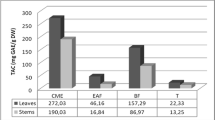Abstract
In order to investigate the antioxidant capacity of sedum (dolnamul, Sedum sarmentosum) and to offer a scientific basis for the medicinal use of it, lyophilized sedum leaves were extracted with n-hexane, n-butanol, ethyl acetate, and methanol, respectively. The methanol extract (ME) showed the highest extraction yield, but no significant differences in the extraction yield were observed. The total polyphenol content (TPC) of the ethyl acetate extract (EAE) and the ME was significantly higher than that of the non-polar solvent extracts. The EAE and ME showed the superior antioxidant activities in the DPPH, oxygen radical absorbance capacity (ORAC), and ferric reducing ability of plasma (FRAP) assays. Lipid peroxidation was efficiently inhibited by the addition of the sedum extracts in the ferric thiocyanate (FTC) and thiobarbituric acid reactive substances (TBARS) assays, but significant differences among the tested extracts were not observed. The ME showed the potent lipid peroxidation inhibitory activity comparable to butylated hydroxytoluene (BHT). The correlations between the TPC and the antioxidant activities based on the DPPH, ORAC, and FRAP assays were highly positive (R 2>0.899).
Similar content being viewed by others
References
Tabart J, Keverx C, Pincemail J, Defraigne JO, Dommes J. Comparative antioxidant capacities of phenolic compounds measured by various tests. Food Chem. 113: 1226–1233 (2009)
Niki E. Assessment of antioxidant capacity in vitro and in vivo. Free Radical Bio. Med. 49: 503–513 (2010)
Ito N, Hirose M, Fukushima H, Tsuda T, Shirai T, Tatenatsa M. Studies on antioxidants: Their carcinogenic and modifying effects on chemical carcinogens. Food Chem. Toxicol. 24: 1071–1092 (1986)
Botterweck AAM, Verhagen H, Goldbohm RA, Kleinjans J, Brandt PAVD. Intake of butylated hydroxyanisole and butylated hydroxytoluene and stomach cancer risk: Results from analyses in the Netherlands cohort study. Food Chem. Toxicol. 38: 599–605 (2000)
Borneo R, Leon AE, Aguirre A, Ribotta P, Cantero JJ. Antioxidant capacity of medicinal plants from the province of Cordoba (Argentina) and their in vitro testing in a model food system. Food Chem. 112: 664–670 (2009)
Moure A, Cruz MJ, Franco D, Dominguez JM, Sineiro J, Nunez MJ, Parajo JC. Natural antioxidants from residual sources. Food Chem. 72: 145–171 (2001)
Kang TH, Pae HO, Yoo JC, Kim NY, Kim YC, Ko GI, Chung HT. Antiproliferative effects of alkaloids from Sedum sarmentosum on murine and human hepatoma cell lines. J. Ethnopharmacol. 70: 177–182 (2000)
Oh H, Kang DG, Kwon JW, Kwon TO, Lee SY, Lee DB, Lee SH. Isolation of angiotension converting enzyme (ACE) inhibitory flavonoids from Sedum sarmentosum. Biol. Pharm. Bull. 27: 2035–2037 (2004)
Qin F, Sun HX. Immunosuppressive activity of the ethanol extract of Sedum sarmentosum and its fractions on specific antibody and cellular response to ovalbumin in mice. Chem. Biodiv. 5: 2699–2709 (2008)
Spanos GS, Wrolstad RE. Influence of processing and storage on the phenolic composition of Thompson seedless grape juice. J. Agr. Food Chem. 38: 1565–1571 (1990)
Ratty AK, Sunammoto J, Das NP. Interaction of flavonoids with 1,1-diphenyl-2-picrylhydrazyl free radical, liposomal membranes and soybean lipoxygenase-1. Biochem. Pharmacol. 37: 989–995 (1988)
Benzie IFF, Strain JJ. The ferric reducing ability of plasma (FRAP) as a measure of antioxidant power: The FRAP assay. Anal. Biochem. 239: 70–76 (1996)
Chung KT, Wong TY, Huang YH, Lin Y. Tannin and human health: A review. Crit. Rev. Food Sci. 38: 421–464 (1998)
Daker M, Noorlidah A, Vikineswary S, Goh PC, Kuppusamy UR. Antioxidant from maize and maize fermented by Marasmiellus sp. as stabilizer of lipid-rich foods. Food Chem. 107: 1092–1098 (2008)
Perez-Jimenez J, Arranz S, Tabernero M, Diaz-Rubio ME, Serrano J, Goni I, Saura-Calixto F. Updated methodology to determine antioxidant capacity in plant foods, oil and beverages: Extraction, measurement, and expression of results. Food Res. Int. 41: 274–285 (2008)
Mukhopadhyay S, Luthria DL, Robbins RJ. Optimization of extraction process for phenolic acids from cohosh (Cimicifuga racemosa) by pressurized liquid extraction. J. Sci. Food Agr. 86: 156–162 (2006)
Cheng Z, Su L, Moore J, Zhou K., Luther M, Yin J, Yu L. Effects of postharvest treatment and heat stress on availability of wheat antioxidants. J. Agr. Food Chem. 54: 5623–5629 (2006)
Sun T, Ho CT. Antioxidant activities of buckwheat extracts. Food Chem. 90: 743–749 (2005)
Arabashahi-Delouee S, Urooj A. Antioxidant properties of various solvent extracts of mulberry (Morus indica L.) leaves. Food Chem. 102: 1233–1240 (2007)
Liu L, Sun Y, Laura T, Liang X, Hong Y, Zheng X. Determination of polyphenol content and antioxidant activity of kudingcha made from Ilex kudingcha C.J. Tseng. Food Chem. 112: 35–41 (2009)
Thaipong K, Boonprakob U, Crosby K, Cisneros-Zevallos L, Byrne DH. Comparison of ABTS, DPPH, FRAP, and ORAC assays for estimating antioxidant activity from guava fruit extracts. J. Food Compos. Anal. 19: 669–675 (2006)
Abbassi MA, Zafar A, Riaz T, Rehman AU, Arshad S, Shahwas D, Hahangir M, Siddiqui SZ, Shahzadi T, Ajaib M. Evaluation of comparative antioxidant potential of aqueous and organic fractions of Ipomoea carnea. J. Med. Plants Res. 4: 1883–1887 (2010)
Frankel EN. In search of better methods to evaluate natural antioxidants and oxidative stability in food lipids. Trends Food Sci. Tech. 4: 220–225 (1993)
Plumb GW, Pascual-Teresa DS, Santos-Buelga C, Cheynier V, Williamson G. Antioxidant properties of catechins and proanthocyanidins: Effect of polymerization, galloylation, and glycosylation. Free Radical Res. 29: 351–358 (1998)
Santos-Buelga C, Scalbert A. Proanthocyanidins and tannin-like compounds: Nature, occurrence, dietary intake, and effects on nutrition and health (review). J. Sci. Food Agr. 80: 1094–1117 (2000)
Foti MC, Dasquino C, Geraci C. Electron-transfer reaction of cinnamic acids and their methyl esters with the DPPH radical in alcohol solutions. J. Org. Chem. 69: 2309–2314 (2004)
Prior RL, Wu X, Schaich K. Standardized methods for the determination of antioxidant capacity and phenolics in foods and dietary supplements. J. Agr. Food Chem. 53: 4290–4302 (2005)
Author information
Authors and Affiliations
Corresponding author
Rights and permissions
About this article
Cite this article
Mo, E.K., Kim, S.M., Yang, S.A. et al. Assessment of antioxidant capacity of sedum (Sedum sarmentosum) as a valuable natural antioxidant source. Food Sci Biotechnol 20, 1061 (2011). https://doi.org/10.1007/s10068-011-0144-0
Received:
Revised:
Accepted:
Published:
DOI: https://doi.org/10.1007/s10068-011-0144-0



